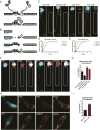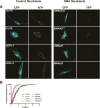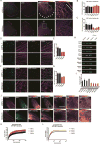The Survival of Motor Neuron Protein Acts as a Molecular Chaperone for mRNP Assembly
- PMID: 28199839
- PMCID: PMC5492976
- DOI: 10.1016/j.celrep.2017.01.059
The Survival of Motor Neuron Protein Acts as a Molecular Chaperone for mRNP Assembly
Abstract
Spinal muscular atrophy (SMA) is a motor neuron disease caused by reduced levels of the survival of motor neuron (SMN) protein. SMN is part of a multiprotein complex that facilitates the assembly of spliceosomal small nuclear ribonucleoproteins (snRNPs). SMN has also been found to associate with mRNA-binding proteins, but the nature of this association was unknown. Here, we have employed a combination of biochemical and advanced imaging methods to demonstrate that SMN promotes the molecular interaction between IMP1 protein and the 3' UTR zipcode region of β-actin mRNA, leading to assembly of messenger ribonucleoprotein (mRNP) complexes that associate with the cytoskeleton to facilitate trafficking. We have identified defects in mRNP assembly in cells and tissues from SMA disease models and patients that depend on the SMN Tudor domain and explain the observed deficiency in mRNA localization and local translation, providing insight into SMA pathogenesis as a ribonucleoprotein (RNP)-assembly disorder.
Keywords: IMP1; SMA; SMN; beta actin mRNA; mRNA localization; mRNP; spinal muscular atrophy.
Copyright © 2017 The Authors. Published by Elsevier Inc. All rights reserved.
Figures







Similar articles
-
RNP Assembly Defects in Spinal Muscular Atrophy.Adv Neurobiol. 2018;20:143-171. doi: 10.1007/978-3-319-89689-2_6. Adv Neurobiol. 2018. PMID: 29916019 Review.
-
Ribonucleoprotein assembly defects correlate with spinal muscular atrophy severity and preferentially affect a subset of spliceosomal snRNPs.PLoS One. 2007 Sep 26;2(9):e921. doi: 10.1371/journal.pone.0000921. PLoS One. 2007. PMID: 17895963 Free PMC article.
-
Deficiency of the Survival of Motor Neuron Protein Impairs mRNA Localization and Local Translation in the Growth Cone of Motor Neurons.J Neurosci. 2016 Mar 30;36(13):3811-20. doi: 10.1523/JNEUROSCI.2396-15.2016. J Neurosci. 2016. PMID: 27030765 Free PMC article.
-
SMN Is Physiologically Downregulated at Wild-Type Motor Nerve Terminals but Aggregates Together with Neurofilaments in SMA Mouse Models.Biomolecules. 2022 Oct 20;12(10):1524. doi: 10.3390/biom12101524. Biomolecules. 2022. PMID: 36291733 Free PMC article.
-
Spinal muscular atrophy: Selective motor neuron loss and global defect in the assembly of ribonucleoproteins.Brain Res. 2018 Aug 15;1693(Pt A):92-97. doi: 10.1016/j.brainres.2018.02.022. Epub 2018 Feb 17. Brain Res. 2018. PMID: 29462610 Review.
Cited by
-
Sumoylation regulates the assembly and activity of the SMN complex.Nat Commun. 2021 Aug 19;12(1):5040. doi: 10.1038/s41467-021-25272-5. Nat Commun. 2021. PMID: 34413305 Free PMC article.
-
HuD and the Survival Motor Neuron Protein Interact in Motoneurons and Are Essential for Motoneuron Development, Function, and mRNA Regulation.J Neurosci. 2017 Nov 29;37(48):11559-11571. doi: 10.1523/JNEUROSCI.1528-17.2017. Epub 2017 Oct 23. J Neurosci. 2017. PMID: 29061699 Free PMC article.
-
Overview of Current Drugs and Molecules in Development for Spinal Muscular Atrophy Therapy.Drugs. 2018 Mar;78(3):293-305. doi: 10.1007/s40265-018-0868-8. Drugs. 2018. PMID: 29380287 Free PMC article. Review.
-
Tudor-dimethylarginine interactions: the condensed version.Trends Biochem Sci. 2023 Aug;48(8):689-698. doi: 10.1016/j.tibs.2023.04.003. Epub 2023 May 6. Trends Biochem Sci. 2023. PMID: 37156649 Free PMC article. Review.
-
Chaperone dysfunction in motor neuron disease: new insights from studies of the SMN complex.Genetics. 2025 Mar 17;229(3):iyae223. doi: 10.1093/genetics/iyae223. Genetics. 2025. PMID: 39907139 Free PMC article. Review.
References
-
- Buhler D, Raker V, Luhrmann R, Fischer U. Essential role for the tudor domain of SMN in spliceosomal U snRNP assembly: implications for spinal muscular atrophy. Hum Mol Genet. 1999;8:2351–2357. - PubMed
MeSH terms
Substances
Grants and funding
LinkOut - more resources
Full Text Sources
Other Literature Sources
Molecular Biology Databases
Research Materials
Miscellaneous

